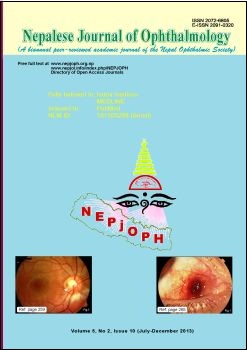Retinoblastoma: geographic distribution and presentation at a tertiary eye care centre in Kathmandu, Nepal
DOI:
https://doi.org/10.3126/nepjoph.v5i2.8708Keywords:
Clinico-histopathology, geographic distribution of Nepal, retinoblastomaAbstract
Introduction: Several aspects of retinoblastoma in Nepal remain enigmatic.
Objective: To assess the demographic and geographic distribution, clinical presentation, and treatment methods of retinoblastoma at a tertiary level ophthalmic institution in Kathmandu, Nepal.
Materials and methods: A retrospective analysis of all the patients diagnosed with retinoblastoma at Tilganga Institute of Ophthalmology from July 2004 to June 2008 was performed. The main outcome measures included region of residence, treatment options and histopathological findings. The histopathological analysis was performed on enucleated and exenterated specimens.
Statistics: The statistical analysis was performed with SPSS Version 11.5. Descriptive statistics are represented as mean ± standard deviation. All tests were two-sided and the P-values of less than 0.05 were considered statistically significant.
Results: Thirty patients presented with retinoblastoma during the study period. The mean age at presentation was 2.5 ± 1.6 years (range five months to seven years). Ten of the 12 patients who presented with bilateral retinoblastoma (83 %) were from the Terai region of Nepal. The ratio of unilateral to bilateral cases in the Terai region was 1:2. This differed significantly with the ratio in the hilly region (Fisher’s Exact Test, p = 0.0012). The mean duration of symptoms before presentation was 2.5 3.2 months (range three days to 12 months). Twenty-four patients (80 %) presented with leukocoria. Eleven patients (36.6 %) presented with leukocoria as their only symptom. Ninety-seven percent of the patients underwent either enucleation (90 %) or exenteration (6.7 %) of at least one eye.
Conclusion: Bilateral retinoblastoma is more prevalent in the Terai region of Nepal. The majority of the patients present with leucokoria and are treated with enucleation.
Nepal J Ophthalmol 2013; 5(10): 169-176
Downloads
Downloads
Published
How to Cite
Issue
Section
License
This license enables reusers to copy and distribute the material in any medium or format in unadapted form only, for noncommercial purposes only, and only so long as attribution is given to the creator.




